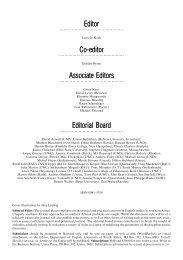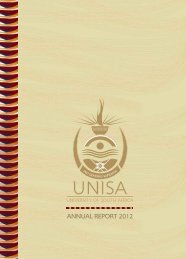Download the Annual report 2011 - Unisa
Download the Annual report 2011 - Unisa
Download the Annual report 2011 - Unisa
You also want an ePaper? Increase the reach of your titles
YUMPU automatically turns print PDFs into web optimized ePapers that Google loves.
The risk management structures that are in place to assess,<br />
manage and monitor risk at <strong>the</strong> university include:<br />
• The Council is responsible for overseeing <strong>the</strong> adequacy<br />
and overall effectiveness of <strong>the</strong> university’s risk<br />
management function and its implementation by<br />
management.<br />
• The Audit and Enterprise Risk Management Committee<br />
of Council has specific responsibility for <strong>the</strong><br />
risk management process and receives <strong>the</strong> risk <strong>report</strong>s<br />
of <strong>the</strong> university, and <strong>report</strong>s to Council on key risks<br />
facing <strong>the</strong> university and associated risk mitigation responses.<br />
• Central to <strong>the</strong> risk management process at <strong>Unisa</strong> is<br />
<strong>the</strong> Risk, Ethics and Controls Committee (a subcommittee<br />
of <strong>the</strong> Management Committee) comprising<br />
members of Executive Management. In <strong>2011</strong> this<br />
Committee met four times to review, evaluate and coordinate<br />
<strong>the</strong>management of identified strategic and<br />
operational risks (financial and non-financial) faced by<br />
<strong>the</strong> university. Management, acting on <strong>the</strong> advice of<br />
its Risk, Ethics and Controls Committee, is accountable<br />
to <strong>the</strong> Council for designing, implementing and monitoring<br />
<strong>the</strong> process of risk management and integrating<br />
it into <strong>the</strong> day-to-day activities of <strong>the</strong> university.<br />
Accountability is established at Management level for<br />
each significant risk and <strong>the</strong> identified portfolio manager<br />
with his/her management team is tasked to<br />
identify relevant measures to manage identified risks.<br />
The control appropriateness of <strong>the</strong> measures is evaluated<br />
and <strong>the</strong> perceived residual risk exposure determined<br />
and monitored.<br />
• A dedicated Directorate: Enterprise Risk Management<br />
comprises competent and experienced staff.<br />
The Directorate oversees <strong>the</strong> process from <strong>the</strong> perspective<br />
of strategic direction, ongoing improvement<br />
in methodology and processes, and technical assistance.<br />
Operational risk registers for a number of departments<br />
have been developed and are in various stages of completion<br />
as reflected in <strong>the</strong> table below:<br />
Summary of operational risk registers developed<br />
Category Description Number (%)<br />
A Completed 56 (58%)<br />
B In progress 35 (35%)<br />
C Not started<br />
– valid reasons available 7 (7%)<br />
TOTAL 98 (100%)<br />
UNISA ANNUAL REPORT <strong>2011</strong><br />
| 58 |<br />
Enterprise Risk Management has matured from operating<br />
under a reactive framework toward being effective<br />
in a wider context of identifying and managing risks<br />
proactively and seeking to introduce best practice initiatives.<br />
All basic structures are in place and operational to<br />
cope with <strong>the</strong> current maturity level. Risk registers are<br />
constantly being updated. However, it is acknowledged<br />
that <strong>the</strong> university has not as yet established enterprisewide<br />
risk and compliance profiles and <strong>the</strong> process of ensuring<br />
compliance will receive additional focus<br />
throughout <strong>the</strong> next planning period and beyond.<br />
In line with its concerted focus on sound corporate governance<br />
and sustainability (Goal 6) <strong>Unisa</strong> has embarked<br />
on a risk-based planning methodology for its 2013-<br />
2015 institutional planning cycle. The planning methodology<br />
is based on <strong>the</strong> national statutory and regulatory<br />
obligations, <strong>the</strong> principles of good practice as established<br />
by <strong>the</strong> King III Code, and <strong>the</strong> institutional requirements.<br />
The most significant risks that <strong>the</strong> university currently<br />
faces include those pertaining to service delivery (14,40),<br />
throughput and success rates (12,92), attracting and retaining<br />
competent staff (12,96), and technology and information<br />
systems (15,91). The criticality factor (residual<br />
rating) of <strong>the</strong>se risks is indicated in brackets. (A rating<br />
scale of 1 to 25 is used: 25 being <strong>the</strong> highest exposure.)<br />
These risks are included in <strong>the</strong> university’s Key Risk Register<br />
and Operational Plan.<br />
The table on <strong>the</strong> following page provides a brief description<br />
of some of <strong>the</strong> key risks to which <strong>the</strong> university is<br />
exposed, and <strong>the</strong> mitigating controls in place to manage<br />
<strong>the</strong>se risks, as approved by <strong>the</strong> Management and<br />
Council.<br />
Identified ‘financial risks’ and ‘non-financial risks’ and are<br />
dealt with in accordance with <strong>the</strong>ir allocated levels of priority.<br />
Financial risks are discussed in <strong>the</strong> Consolidated Financial<br />
Statements.<br />
Insurance policies are in place to cover risks. These are<br />
monitored by <strong>the</strong> Finance Committee, which satisfies itself<br />
that cover against fire and related risks, accidental<br />
damage, business interruption, <strong>the</strong>ft, money and fidelity<br />
and, critically, both public and employee liability is adequate.<br />
Despite <strong>the</strong> evident progress, <strong>the</strong> university acknowledges<br />
that embedding <strong>the</strong> awareness and understanding<br />
of risk management so that it becomes part of <strong>the</strong> integrated<br />
culture of <strong>the</strong> organisation is an organic process.

















